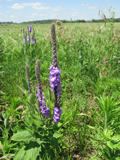
Important nectar source for butterflies. Host plant for common buckeye butterfly. Long bloom period from July to Sept.
The 1-4 ft., hairy stem produces a terminal cluster of narrow, flowering spikes. Small lavender flowers appear in a ring halfway down the acsending spike. A common invader of overgrazed pastures, this plant does not compete well in vigorous stands of native grasses. Seeds are consumed by small mammals and prairie-chickens.
This species is a member of the verbena family (family Verbenaceae), which includes about 75 genera and 3,000 species of herbs, shrubs, and trees, mostly of tropical and warm temperate regions. Among them, teak is a highly prized furniture wood, and Vervain, Lantana, Lippia or Frog Fruit, and Chase Tree or Vitex are grown as ornamentals.
More from USDA Plants Database »